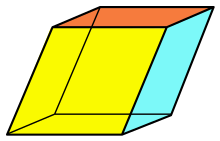Prism (geometry)
A prism (plural: prisms ) is a geometric body defined by parallel displacement of a planar polygon along a not in this plane lying straight line in the space is formed. One also speaks of an extrusion of the polygon. A prism is therefore a special polyhedron .
The given polygon is called the base area , the opposite side area is called the top area . The totality of all other side surfaces is called the lateral surface . The side edges of the prism, which connect the base and top, are parallel to each other and all of the same length. The base and top are congruent and parallel to one another . The distance between the base and the top surface is called the height of the prism.
Straight and oblique prism
If the parallel displacement of the polygon is perpendicular to the base, it is called a straight prism , otherwise it is called an oblique prism . The outer surface of a straight prism consists of rectangles , in the general case it consists of parallelograms . A straight prism with a regular polygon as a base is called a regular prism .
The body, which is dual to a straight prism, is a double pyramid .
Regular prism
A straight prism with a regular polygon as a base is called a regular prism . All regular prisms have an orb because all corners are equidistant from the center . The cube is the only equilateral prism with an inc sphere .
triangular prism
square prism
pentagonal prism
hexagonal prism
heptagonal prism
octagonal prism
nine-sided prism
decagonal prism
eleven prism
dodecagonal prism
Formulas
| Sizes of a regular prism (regular n- corner with side length a as base and height a ) | |||
|---|---|---|---|
| General case | Square prism | Regular triangular prism | |
| volume | |||
| Surface area | |||
| Umkugelradius | |||
| Inner angle of the regular base | |||
| Angle between base and rectangles | |||
| Angle between the rectangles | |||
| Solid angles in the corners | |||
Special cases and generalization
The cuboids and cubes are special forms of the prism . With these, each side can be understood as the base of the prism.
In optics , a prism is usually understood to be a straight prism with a triangle as its base, see prism (optics) .
In mathematics, the prism is a special case of the general cylinder .
symmetry
Every prism with a point-symmetrical base is itself point-symmetrical.
Formulas for volume, surface area and surface
The volume of a prism is given by
- ,
where denotes the area of the base and the height of the prism. From Cavalieri's principle it follows that two prisms (e.g. a straight and an oblique prism) have the same volume with the same base area and height .
The lateral surface of a straight prism is given by
- ,
where stands for the circumference of the base and the height of the prism.
The entire surface of a prism results from
- ,
where and correspond to the content of the base area and the lateral area .
Umkugel
Only right prisms with a base which has a radius has to have a circumscribed sphere . All regular prisms and all straight triangular prisms therefore have a sphere. The radius of the sphere with a given height and given circumferential radius is calculated according to the Pythagorean theorem :
Incugel
Both straight and inclined prisms can have an inc sphere .
With a given height of a prism, the radius of the inc sphere results in:
Precondition for the existence of an inc sphere :
- There is an imaginary plane that is perpendicular to all parallelograms of the mantle. The intersection of this plane with the parallelograms results in a polygon .
- The polygon from FIG . 1 has an inscribed circle .
- The radius of this inscribed circle is .
Edge ball
Only straight prisms with a regular polygon as a base and all edges of the same length have an edge sphere . The jacket of such prisms is thus formed from squares . With a given circumferential radius , the radius of the edge sphere results in:
See also
literature
- Prism . In: Meyers Großes Konversations-Lexikon . 6th edition. Volume 16, Bibliographisches Institut, Leipzig / Vienna 1908, p. 354 .
- Bronstein-Semendjajew, Taschenbuch der Mathematik, 21./22. Ed. 1981, p. 196.
Web links
- Prism on mathematische-basteleien.de
- Eric W. Weisstein : Prism . In: MathWorld (English).














































